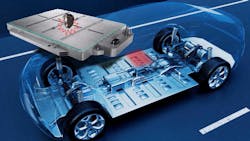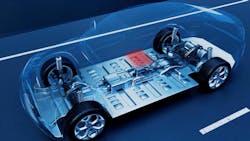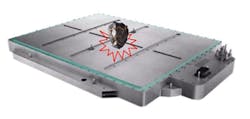EV Battery Collision Monitoring System Based on Touch-Sensing Tech
This article is part of the TechXchange: EV Battery Management.
What you'll learn:
- How Taifang's BIMS monitors collisions and their impact on EV batteries.
- The elastic-wave touch-sensing technology behind BIMS.
The Battery Intelligent Monitoring System (BIMS), recently unveiled by Taifang Technology, employs the company’s elastic-wave technology to monitor and report collisions experienced by electric-vehicle (EV) batteries.
In the past, collision-perception methods based on acceleration have faced tenacious challenges. These include the inability to accurately detect subtle micro-collisions, as well as the issue of false triggering in non-collision scenarios. It’s led to difficulties in effectively monitoring and perceiving mild collisions.
Nailing the intensity of collisions to the chassis is important to Taifang, as it provides battery-damage data and early warning alerts to drivers or remote operators.
The company previously introduced its Taifang Automobile Intelligence Perception System (TAIPS), which enables a vehicle to perceive anything from innocuous human contact to serious collisions. Just like TAIPS does with a vehicle’s “skin,” BIMS captures data from sensors in vehicle batteries, providing drivers and operating platforms with information on vehicle incidents.
Mass Production of BIMS in 2024
Crash safety is considered in almost all standards that relate to battery testing, such as the ECE R100 certification, one of the main European requirements for type approval of electric road vehicles. R100 testing for EVs stipulates that the system must come to a safe voltage within 60 seconds after a crash.
Taifang says its solutions can be applied to virtually any solid surface, including metal, glass, wood, plastic, and composites. BIMS is expected to be integrated into vehicles in mass production in 2024, contributing to intelligence and driving safety.
Collisions—From Minor to Major
BIMS addresses a significant potential hazard to electric vehicles by monitoring and reporting on collisions. An EV’s battery can be damaged easily when the vehicle’s chassis encounters a collision—even a bump or scratch could damage the battery.
Severe collisions will cause mechanical deformation of the battery, leading to rupture deformation of the battery separator and potentially direct contact between the positive and negative electrodes of the battery. This would induce an internal short circuit.
Stranded energy in EV batteries is defined as the energy remaining inside any undamaged or damaged battery following an accident. In the absence of proper monitoring and handling, a potentially damaged battery might go into thermal runaway, thereby leading to potential loss of life and property damage.
Taifang is engaging with multiple car manufacturers to conduct various tests with the BIMS system. “With the rapid growth of new-energy vehicle sales, the safety of power batteries directly affects the safety of entire vehicles,” said Charles Du, Taifang founder and CEO. “This, in turn, affects the safety of drivers and passengers. ‘’
Collision Monitoring at Low Speeds
The company’s elastic-wave TAIPS technology aims to endow smart automobiles with tactile perception ability, thereby improving driving safety and the user interaction experience. For self-driving vehicles, especially when operating at low speeds, elastic-wave touch sensing can detect collisions and trigger braking to prevent secondary collisions, thus helping to ensure the safety of pedestrians and avoiding further damage.
The technology's sensitivity enables it to detect collisions even at extremely low speeds, such as 1 km/h. This heightened sensitivity ensures that even minor incidents are accurately captured, contributing to comprehensive incident detection.
TAIPS operates by positioning elastic-wave sensors on the internal ‘’skin" of the vehicle. These sensors are designed to detect the propagation of elastic waves that occur when the vehicle's body comes in contact with external objects. By focusing on the characteristics of these elastic waves, TAIPS can distinguish between different collision events, thereby mitigating the challenges associated with false triggering.
The system responds distinctly only when there's an actual collision resulting in contact with the vehicle's surface. In the case of mild collisions affecting the battery, the system can assess the collision's impact and issue appropriate alerts, safeguarding driver safety and prolonging the vehicle's lifespan.
Read more articles in the TechXchange: EV Battery Management.


